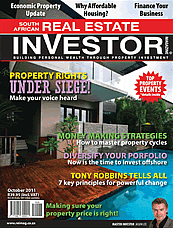Cautious optimism as buyers breathe life into residential property
Data does not yet reflect the transactions of the last three months which estate agents have described as “surprisingly brisk”.
However, this welcome activity is taking place against worsening economic circumstances. More than 2m South Africans have lost their jobs as the lockdown, in its most severe form, severely reduced or put an end to business activity not considered essential.
Add to this the emergence of a “second wave” of Covid-19 in the northern hemisphere and it becomes apparent that it is still too early to predict the consequences of what was effectively an unprecedented global economic shutdown to a Black Swan event.
South Africa, though, has come through Covid-19 in better shape than was anticipated. Many sectors of the economy are open or opening, although some businesses have permanently closed down and others are reduced in size. While the high-employment tourism sector remains effectively shut to foreign visitors, its primary source of revenue, other business sectors are fully operational and gathering momentum.
Importantly, though, it’s gathering momentum while keeping an eye on social distancing, wearing face masks and sanitising. As the country navigates these unchartered waters, it is useful to look back at a previous recession to see how we rebounded and to revisit our scenario modelling of a few months ago.
The Great Recession of 2008-9 brought about the last pre-Covid19 dip in the South African property market.
That recession in SA lasted nine months although its impact on the property market filtered through in 2010 when we recorded the lowest number of transfers since 2001 - until of course the Covid19-induced recession.

While the recovery in transfer volumes had not yet reached the pre-2008 numbers (see graph above), the total investment in residential properties rose from around R140b in 2010 to above R240b in 2014 (see graph below) and was edging towards R250b when Covid-19 hit.

As lockdown levels have eased, activity in the residential property market has increased. Although it is early in the recession-recovery cycle, the data in the third quarter of this year shows a welcome improvement on the second quarter.
There is pressure from both sides of the market. People are downscaling from high value properties and simultaneously we are seeing upward pressure from new buyers coming out of the informal housing market who are moving into the formal affordable segment, specifically in rural areas, townships and within settlements on the outskirts of larger metropoles.
Lightstone has tracked three key drivers of long-term house price growth from previous market crashes and recoveries: GDP growth, CPI growth and movement of interest rates. But with little or no certainty on how this Black Swan event will play out, Lightstone modelled three scenarios around the impact of Covid-19 and the lockdown based on the GDP dropping between 3% and 10%. As it happens, South Africa’s Finance Minister Tito Mboweni expects our economy to contract by just over 7% percent, its largest shrinkage in nearly 90 years.

And how would that impact residential sales? Our second scenario assumed a drop in GDP of 6% and house price inflation of -8.8%. But the successive interest rate cuts by the SARB has helped offset the economic contraction and so we expect house price growth to settle in line with our best-case scenario, at around -3.9%, by year’s end.
Lower interest rates and the ongoing correction of property prices has created a market ripe with opportunity for those looking to enter the market or buy up – or for those looking to buy second properties as investments or holiday homes.
High value homes have led the second home market since the 2010 (graph below), and in fact Lightstone data indicates that activity at the top end of the property market tends to signal recovery after a recession. The top end tends to lead the rest of the market by about two months. Smaller buyer and seller “pools” make it more price sensitive, and while prices tend to fall first, they typically lead the recovery too.

This graph below looks at the categories in a different way and shows the relative rise of the luxury category to joint second with mid-value properties in 2020.
Along with the consistency of the super luxury category, the growth of the luxury category in 2020 suggests that the wealthy are relatively unscathed by the current recession, and that it is the mid-value category that is, relatively speaking, most affected in the second home category.
While freehold second property purchases have remained constant around 54% to 57% from 2010 to 2019, estate sales have nudged upwards from 17% in 2010 to 21% in 2019. Conversely, sectional title sales have dropped sharply from a high of 27% in 2013 and 2014 to 21% in 2019.
Both estates and sectional title living tend to offer greater security than freehold, but estates typically offer the benefits that come with freehold house ownership but with the security benefits typically associated with sectional title. We expect demand for estate living to increase for some time to come.

By far the majority of second properties are in fact bought in the same province as the owner’s primary residence.
Those in the Western Cape appear to have a real affinity with the province as 91% own second homes within provincial borders, followed by the Eastern Cape at 87% and Gauteng at 85%. Same province purchases are most likely because buy-to-rent is easier to manage closer to home.
People are buying second properties at a relatively young age – and the figures have remained relatively consistent since 2010. The leading group at between 51% and 56% is the 24-40 age group. Next is the 40-49 age group, with the 49-64 age group declining from 20% in 2016 to just 15% in 2020.

Millennials account for 56% of buyers purchasing second properties

